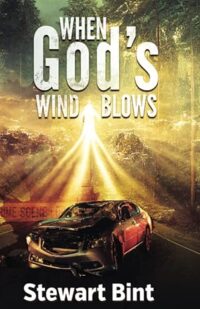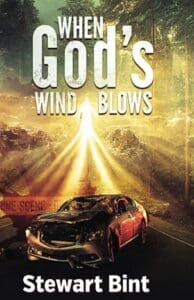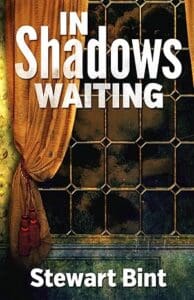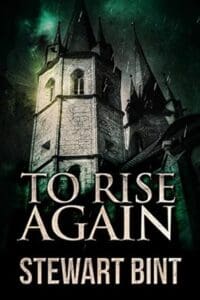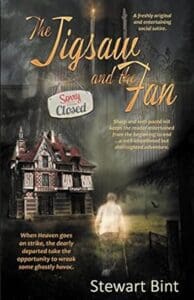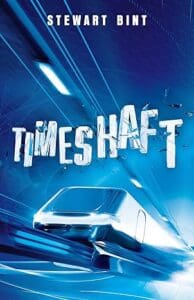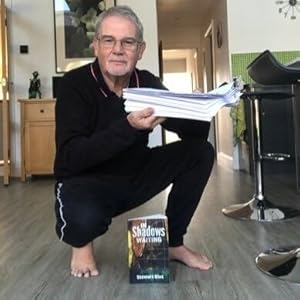Author of multiple and blended genres Stewart Bint discusses his novel When God’s Wind Blows, a dark concoction that mixes COVID, terrorism, and the paranormal.
When God’s Wind Blows
If you thought the horror was over at the end of In Shadows Waiting, think again.
This sequel, set almost 40 years after the tragic events at White Pastures, is a paranormal crime thriller with a COVID backdrop, showing how grief and love affect one man’s sanity.
After a young couple are ruthlessly gunned down outside their home during the pandemic, we weave our way through Simon Reynold’s personal COVID nightmare as he seeks answers about the mysterious blackouts he’s experienced since his sister died at the hands of a supernatural entity back in 1982.
Slowly but surely, paranormal events intertwine Simon’s Long Covid journey with Adam and Hayley Hampshire’s murder, unveiling a plot to terrorise the entire world.
When God’s Wind Blows is a paranormal tale of love, insanity, and tragedy of epic proportions.
The Interview
1. A Sequel: Shadows of Shadows. Although the events of In Shadows Waiting inform Simon’s and other characters’ perspectives and shape their experiences, the stories seem to be quite different: why did When God’s Wind Blows need to be a sequel rather than a standalone? Although I found the sequel’s discussion of events and ideas related (I assume) to its predecessor easy enough to follow, since I read it without first reading In Shadows Waiting, I wondered if I might be missing key information. Beyond what’s in the book description (above), what would you have readers know about the book set forty years prior to When God’s Wind Blows should they decide to start with the more recent volume? How did your feelings about the world of In Shadows Waiting and about Simon evolve during the years that passed before writing When God’s Wind Blows? How has your writing changed?
SB: You’ve hit the nail on the head with your very first question. When I started planning the book, it was never intended to be a sequel. It was going to be a standalone sci-fi novel with entirely different characters – no connection to the Reynolds family at all.
My original idea was that the movements in time would be part of a scientific project, with a scientist being the main character. As I was plotting the storyline I couldn’t see a feasible ending, and there was no conflict, so I quickly realised that I needed to change direction. I switched the time movements to become the paranormal events they are in the book today, and the scientist became a retired police inspector. The conflict was going to be between that character and a criminal he caught 25 years earlier, who has just been released from prison.
This raised another barrier, though, in that I’d need to devote considerable time to getting a hard-nosed ex-policeman to accept the paranormal, which could take several chapters. So, who did I know who’s already accepted the paranormal and gone through a horrific paranormal experience? Simon Reynolds, nearly 40 years ago.
Re-reading In Shadows Waiting, I saw how easy it would be to link the two stories and have the cause of events in When God’s Wind Blows directly connected to what had happened in the original book.
The important points from In Shadows Waiting are all dealt with through Simon’s flashbacks and memories, which I hope I handled in a realistic way. Although readers of In Shadows Waiting would learn more about Simon’s early years and experience the gradual paranormal buildup to the horrific shattering climax of events in 1982, When God’s Wind Blows can be enjoyed in isolation from it.
It was wonderful to get back inside Simon’s head and discover what’s been happening in the years since I said goodbye to him. Set in 1982, the time of In Shadows Waiting is much simpler than today’s world – it’s the start of the computer era and includes scenes of Simon with his £2,000 Amstrad Multimedia PC and a Commodore.
Overall, since that first book, my writing has become more brutal but balanced out with humour. Both aspects are found in abundance in When God’s Wind Blows.
2. COVID Phenomenology. Your introduction to When God’s Wind Blows mentions people who helped enrich your understanding of the experiences of COVID and Long COVID, experiences you describe in great detail from initial symptoms through the disease’s deadly onslaught and into its nightmarish lingering. Why was capturing these details important to you? During quarantine, many artists stayed busy (what else were we supposed to do?), but your book immersed me in the terrors of COVID more than any other book or film I’ve yet encountered. Would you describe the book’s immersion of the reader into the suffering of the disease as COVID horror? Why or why not? Do you think that, as the world has more time to reflect on the global disaster, we’ll see more artistic attempts to wrestle with people’s experiences in genres akin to horror (or “paranormal crime thriller”)? Why or why not?
SB: As the book relies on readers’ acceptance of something outside their everyday experiences and lives, capturing real-life details was of paramount importance in nudging the unbelievable towards being believable.
Yes, I believe what starts out as Simon’s COVID nightmare turns into horror, both for him, and, as the story develops, for the rest of the world. Although my publisher was happy with the COVID storyline, a number of publishing houses publicly said in the aftermath of the pandemic that they wouldn’t touch fiction which focuses on it. I personally think that’s a short-sighted approach, and believe that over time, as the memory of COVID fades for the lucky ones who escaped unscathed by the initial infection, and later by Long COVID, novels will emerge reflecting diverse perspectives.
3. Coma and NDE. Your book extends its phenomenological reach when it explores the experience of a medically induced coma, an area that seems to defy reliable documentation. How much do you feel that your representation of coma experience is factual—typical of what a coma patient encounters—and how much is fictionalized? Why do you feel the way you do? Similarly, your book chronicles Near Death Experience (NDE), a popular topic in paranormal nonfiction less often explored in fiction. What were your sources for representing NDE, and how confident do you feel about having gotten it “right?” Why are the mysteries and terrors of coma and NDE so important in the book?
SB: For the story to be believable, it’s absolutely vital that unknown quantities such as what patients experience in medically induced comas are as realistic as possible. That’s the reason I focus in great detail on what happens in the run-up to those scenes – for example, life on the wards and the medical procedures were all written after extensive interviews with junior doctors. That leads to what I hope is a seamless transition from well-documented real-life situations to the paranormal scenes.
While we only have unverifiable testimonies from people who’ve experienced NDEs while in comas, I wanted to make what happened to Simon as believable as I could. I carried out an extensive interview with someone who had a brief out-of-body experience while in a diabetic coma for several weeks. Simon’s experiences when he physically leaves his body, both in a medically induced coma and towards the end of the book, are a fictional representation of what she saw during her ‘journey.’ So, I’m confident that any reader who’s had a similar experience can identify with at least part of what happens to Simon on the other side of the portal.
Many of my novels have a paranormal element, reflecting on what might happen after death. For example, In Shadows Waiting touches on reincarnation, and we have spirits existing in another plane of existence; To Rise Again explores reincarnation more fully but with a violent and brutal storyline; my satirical novel, The Jigsaw And The Fan, looks at ghosts and the afterlife of Heaven and Hell in a wildly humorous, slapstick, style; while When God’s Wind Blows looks at existence after death both as individual spirits and as becoming one with the spiritual universe.
4. Life After Death. Through coma, NDE, and other experiences at the limits of consciousness, When God’s Wind Blows seems to endorse the idea that some aspect of a human individual continues beyond death. Does or do specific religious perspective(s) inform this idea? Would you consider this idea to be a “message” in the book? Why or why not? Despite the book’s terrors of disease and violent death, it offers many promises of hope. Do you see your depiction of a realm beyond death as the book’s greatest reassurance, or might you emphasize other reassurances—such as family and community–instead?
SB: Yes. Absolutely, to all your questions in Part 4.
My four paranormal novels each explore different ways of humans continuing after death in some form or another – individual ghosts, spirits, reincarnation, even one character who was violently raped and murdered centuries ago becoming a guardian angel in When God’s Wind Blows.
So, that’s definitely the message, not only from this book, but from most of my others, too. And I think that whole concept can be traced back subconsciously to my earliest fiction as a young child. I started writing little sci-fi stories from the age of seven. My fictional worlds became invaluable to me when my Dad died when I was 11. I retreated more and more into those places where I was in control of my characters’ fates, knowing that whatever happened to them in the stories, they’d be okay in the end. My fictional worlds were certainly better than the real one at that time.
Let me pose a question to everyone reading this, that I’ve been pondering for years. My Dad’s death had a profound and lasting effect on me. Do you think the message in my books about death not being the end is my way of hoping that my Dad never really left me, and still exists in another plane?
5. COVID’s Physical and Psychological Legacy. Simon and his family endure many physical and psychological traumas because of his struggle with COVID, traumas readers are likely to connect to experiences they witnessed or endured themselves. Taking Simon as a figure for what whole communities (and to an extent the entire world) endured, how does your book reflect on the ways COVID might have changed people’s perceptions of and relationships with their bodies and with public health concerns? Similarly, how does your book reflect on the mental health concerns created by and related to COVID—what is the pandemic’s psychological legacy?
SB: The pandemic meant many people had to fight a lonely battle against COVID, and while it was horrific at the time, I suspect the memory is beginning to fade for most, now, as the brain seeks to protect them. Overall, I believe COVID brought good health and fitness into close perspective, making most people more aware of how vulnerable their bodies can become. It also split public opinion over the battle between personal freedoms and the collective safety – to quote Mr. Spock from Star Trek: “The needs of the many outweigh the needs of the few.”
The long-term mental health effect is likely to be different from the physical aspects of COVID, especially on the young, after the enforced lockdowns promoted feelings of being disconnected. But maybe the pandemic’s lasting legacy is that it has normalised discussions about mental health and shown people – men particularly – that it’s okay to talk about their mental health and to ask for help.
6. Paranormal Time. When God’s Wind Blows flows too smoothly, I think, to be labeled “experimental,” but it does have an unconventional narrative structure that moves back and forth in time, notably beginning with the murders mentioned in the description above, jumping backward, and not coming back to the murders until the novel is about seventy-five percent complete. Why did you choose this approach? How did the non-linear structure affect your writing experience? How do you expect it to shape the reading experience? I’ll risk a bit of a spoiler and say that non-linear time relates to some of the book’s paranormal elements. Without giving away much more, can you explain your (or at least your book’s) understanding of how time operates in a universe where paranormal forces interact with everyday people living everyday lives? Why does it work that way?
SB: I like to open my books with either a burst of action, or something that teases the way forward. Alternating the early chapters showing the murder and start of the police investigation, with Simon being infected with COVID and highlighting some of his background through memories and flashbacks, before parking the murder on a cliffhanger, showed both roads the story would take. If everything in When God’s Wind Blows was done in strict chronological order, I don’t believe the tension would have been built as successfully as I hope it did. I appreciate the non-linear structure may require additional concentration, but I like to think everything was sufficiently signposted, and readers didn’t get lost on the way.
Throughout the book, time works in a normal way for everyone except Simon, and the paradox is that he began to experience something in 1982 which wasn’t created until COVID in 2020. I love paradoxes, especially a huge one in my time travel novel Timeshaft, where the main character uses the Timeshaft to travel back in time to create the Timeshaft itself, and the entertaining scene where the time traveller has dinner with his mum and dad when she’s pregnant with him!
7. Terrorism. After the murders that begin the novel, authorities—with trepidation—speculate that they might be acts of terrorism. What inspired you to weave the possibility of terrorism together with a chronicle of the pandemic? As some of your characters eventually reflect, one of terrorism’s goals is to make everyone feel unsafe, and though a deadly disease might not have a “goal,” it arguably has the same effect. In this sense (within your pages), are terrorism and COVID mirror images of each other? Why or why not? Returning to matters of genre, terrorism shows up most often in action-adventure stories, sometimes thrillers, but considering that its focus is, well, terror, do you think it’s more at home with horror and the types of stories where the paranormal might appear? Why or why not?
SB: I brought terrorism into the novel to be the conflict that had been missing from the original concept when it was going to be a sci-fi story. The protagonist [or the person who becomes the antagonist, from Simon’s perspective–LAC] made what everyone else believes is terrorism to be a mirror image of COVID because he genuinely believes it is God’s will. So, it poses the question, ‘Which is truly God’s Wind? – is it COVID, which he believes God sent to wipe the infestation of humanity from the face of the Earth, or is he God’s wind, in trying to prevent humanity’s fightback against it?
Terrorism can take many forms, and, indeed, one Amazon reviewer of When God’s Wind Blows says: “He has taken the events of the last several years and built a story that absolutely scared me to my soul. Stewart has, in this story, shown us just how easily a terrorist cell could take advantage.”
Terrorism is defined as ‘the unlawful use of violence or threats to intimidate or coerce a civilian population or government, with the goal of furthering political, social, or ideological objectives. It involves acts that create fear and harm for a political, ideological, religious, or economic objective.’
Using this as the guide, I’d say that stories in any genre could revolve around terrorism in some form.
8. Apocalypticism. Apocalyptic, often Biblical rhetoric wasn’t uncommon as people grappled with the horrors of the pandemic, a phenomenon your book’s title seems to foreshadow and that your story does address. What’s your view of people’s readiness to embrace apocalyptic thinking in the new millennium? Does your book take a position on this tendency? For many, COVID felt like a personal apocalypse, but how much do you want your readers thinking about a future of more plagues and other forces that threaten the globe? Is the world of your novel spiraling inevitably toward its end?
SB: Not sure the world in When God’s Wind Blows was spiraling towards its end, but, of course, in the final section, entitled ‘Afterwards,’ I do say maybe the Earth isn’t finished with keeping humankind in check and could show us in other ways that while mortals think we’re in charge of our destiny, in truth, we’re not.
The Doomsday Clock has been so close to midnight for many years now, and the news media is full of situations where an apocalypse could be triggered, that I think people have become immune to the idea of it. It’s something we all think about when we worry about the future of our children and grandchildren, but we don’t really see it happening. The thoughts are that humanity will step back from the brink. However, When God’s Wind Blows’ stance on this is that supernatural forces had to combine against the protagonist, so maybe humanity isn’t as smart as we think we are.
9. “Evil Stuff in the Name of Grief.” When God’s Wind Blows deals with many traumas in addition to those tied to COVID, and some of those traumas, left unresolved, lead to grief that motivates villainous behavior, something the villains in both In Shadows Waiting and its sequel have in common. Why did you choose to make grief such a strong motivator for your villains? What about grief brings on a tendency toward “evil stuff?” On individual and cultural levels, how might we process the grief over tragedies like the losses of loved ones—to COVID or to other forces that seem unjust—and avoid the sorts of evils that your stories depict?
SB: Both villains had originally been good people, but I wanted to show how one force could be so powerful that it affects the stability of their minds. Grief was the plot device to portray that powerful force, which, in In Shadows Waiting, affected only one family, but extended to real “evil stuff” in When God’s Wind Blows to twist one man’s sanity so much that it drove him to potentially destroy the whole world. Grief ain’t to be messed with! And it becomes even more powerful when you realise it’s two people grieving over the same person – one in In Shadows Waiting, and one in When God’s Wind Blows.
10. Access! How can readers learn more about you and your works (please provide any links you want to share)?
SB: My combined website and blog is the best way to find out all about me and my books: Stewart Bint Author – Home. You’ll find individual book links to Amazon and a couple of other outlets, under the Fiction tab there.
My Facebook author page: Facebook
I’m always happy to connect with anyone on X (formerly Twitter): @AuthorSJB, and Bluesky: @stewartbint.bsky.social.
About the Author
Stewart Bint is a novelist and magazine columnist. He lives with his wife, Sue, in Leicestershire in the UK, and has two grown-up children, Christopher and Charlotte, and spends a lot of time now with his young grandson, George.
He is a former PR writer, radio presenter, newsreader, and phone-in show host, but he always wanted to be a fiction writer—a dream that came true when his first novella appeared as an ebook in 2012 at the age of 56. His first paperback came out three years later. When God’s Wind Blows is his sixth book, and the sequel to his first novel, In Shadows Waiting.

